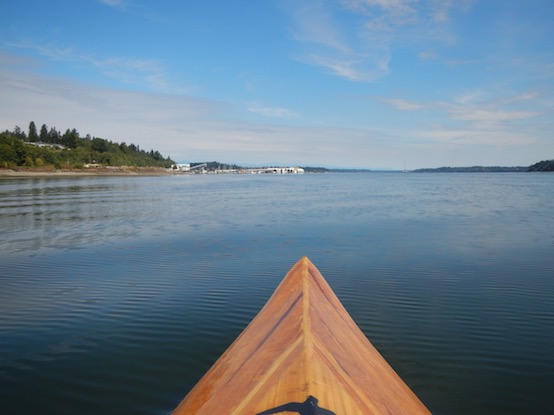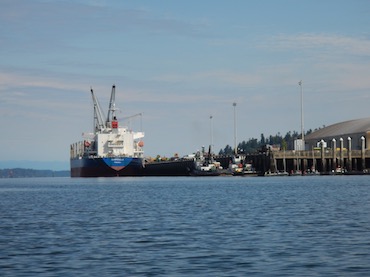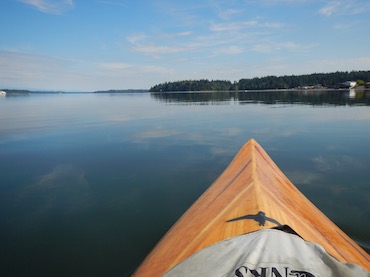Big Water
11/08/15 06:42

In my everyday life, the most common place for me to paddle is Sheridan Lake. I paddle there because it is close and convenient. The lake is big enough to enjoy. At about 375 acres, there are plenty of little coves and inlets to make the shoreline interesting. The center of the lake is large enough to develop a few waves when the wind is blowing, without being threatening to small craft. I tell people that my motto is, “If your lake is to small, get a smaller boat.” When I’m paddling in my little boats, the lake is just fine. Because I paddle there a lot, I know the lake very well. I can paddle the entire shoreline in a couple of hours and I often paddle across the lake one way and around it on the way back. I like to check out the inlet and paddle upstream past the bridge to the campground from time to time. There are plenty of familiar sights to which I like to return, such as the beaver dams or waterfowl nesting areas.
Over the years I have paddled my boats in many different places. My experience, however, remains mostly in small waters.
When I come out here, however, I dabble in the big waters. Of course, I’m not equipped or experienced enough to go any distance from shore without a guide and I need to stay off of the big waters when the weather is threatening, but I can paddle along the shore in many different places.
There is really no way to compare the Puget Sound with my little lake. (OK, I know that Sheridan Lake isn’t really “mine,” it’s just familiar to me.)
From Olympia, where I usually launch at Percival Landing, right in the downtown, the sound stretches 100 miles north to Deception Pass. There is one major and two minor connections to the open Pacific Ocean. Admiralty Inlet is the major connection, and Deception Pass and Swinomish Channel are the minor connections. I could paddle my canoe through either of those connections, as long as I was aware of the currents in those places. A few years ago we were up north and I watched the kayakers in Deception Pass and realized that you have to have some experience and local knowledge to be able to make progress in the swift current up there.

I know that my skill and my small boats are no match for this gigantic body of water, so I am careful to only paddle along the shore in protected places.
Still, there is a sense that comes from paddling on big water that makes an impression. For one thing, there are some gigantic boats in this water. I watch the loading and unloading of ocean-going vessels at the Port of Olympia. There is an ongoing log loading process there. There is a huge area filled with logs that are transported by giant machines and loaded with multiple cranes for each ship. The ships are so big that they need to wait for high tide to head out when loaded. The amount that they settle into the water when loaded is impressive.
Even the pleasure craft that are at the Olympia Yacht Club marina are big by our standards. Any boat under 30’ long looks small in that arena. There are private vessels with a couple of masts stretching skyward, and lots of large motor cruisers that probably have accommodations that make our travel trailer appear small by comparison. During the week when there is less activity at the marina, I paddle up and down the rows, looking at all of the gorgeous boats. There are a few wooden boats that appear to have been around for a while and plenty of sleek fiberglass models as well as aluminum and steel craft. Mostly I am looking at them from the waterline and often get to see only the transom at the stern of the craft. I read their home ports - mostly places around the sound, but there are always a few vessels from Portland, OR, various places in California and British Columbia. Occasionally I’ll see a craft from Alaska, and sometimes there will be a world cruiser from a long away port. I’ve seen a couple of boats with home ports on the East Coast. No matter how they traveled, it is a long way from Boston to Olympia WA.

Compared to the sailors of old, who headed out in comparatively small craft to explore the oceans and discover points previously unknown to their people, my little explorations of the coastline of the Puget Sound are minor excursions. But I have the feel of an explorer as I head out. The places I visit are previously unknown to me and I have a tendency to stretch out and cover a bit more space each day that I am able to paddle on the big waters of the sound.
I’ll never be a big water sailor and I’ll never go very far in my boats, but the boats give me a sense of freedom and adventure that are appropriately sized to my age and level of skill as a mariner. As long as my imagination continues to soar, the water is far too big for me to ever become bored with my adventures.